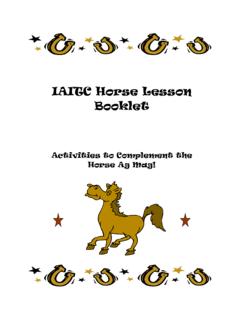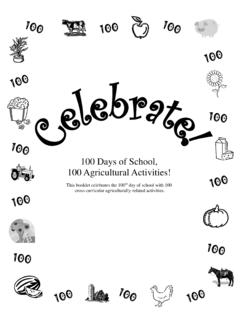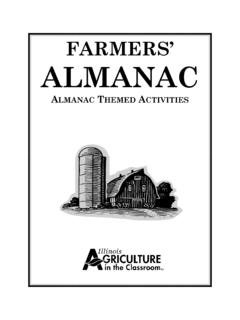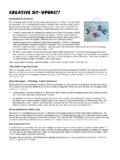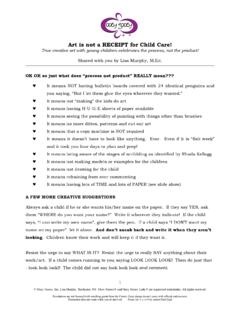Transcription of paper products, cotton - Illinois AITC
1 CottonUSES: plastics, paper products, films, yarns, cosmetics, clothing, soaps, shoe strings, pillowcases, denim, dollar bills, cooking oil, salad dressing, livestock feed, natural fertilizer for lawns, cosmeticsCotton is one of the most important crops grown in the United States. cotton is a soft, fluffy staple fiber that grows in a boll around the seeds of cotton plants. There are three primary products derived from cotton production: cotton lint, linters and cottonseed. cotton lint is used in clothing, shoe strings, pillowcases, denim, towels and dollar bills. Linters are used in plastics, paper products, films, yarns and cosmetics. Cottonseed is crushed into three separate products oil, meal and hulls. The oil is the cottonseed s most valuable by-product. It is obtained by crushing the cottonseed kernel. The oil is used in cooking oil, salad dressings, soaps, cosmetics and in preparation of snack foods like chips, crackers and cookies. The hulls are used in livestock feed, fertilizer, fuel and packing materials.
2 The meal is the second most valuable by-product of cottonseed. Meal is made by grinding the cottonseed and is used in livestock and poultry feed, as well as natural fertilizer for lawns, gardens and flower beds. What is cotton ?Ripening bollSquareBALE: a bundle of cotton fiber, tightly compressed and secured with : the seed-bearing part of the cotton plant in which the cotton fibers are formed. DYE: a natural substance used to add a color to or change the color of something. FIBER: a fine, threadlike piece, produced by the cotton plant. Furrow: a narrow groove made in the ground, especially by a : a machine that quickly and easily separates cotton fibers from their seeds. HULLS: the outer covering of the : the artificial application of water to land to assist in the production of : the raw fiber from the cotton plant which is pressed into bales at the cotton gin. LINTERS: short fibers that cling to the seed after the lint is removed. MEAL: the second most valuable by-product of cottonseed.
3 Meal is made by grinding the cottonseed. SPINNING: to make (yarn) by drawing out, twisting and winding : to interlace (threads, yarns, strips, fibrous material, etc.) so as to form a fabric or material. YARN: a long continuous length of interlocked fibers. VOCABULARYStemFlowerBoll ready for harvest12,000 cotton cloth was used to wrap mummies in Egypt. 3000 Archaeologists have found cloth fragments, proof that cotton was being grown in the Indus Valley of India (Pakistan). Natives of Egypt s Nile Valley were making and wearing cotton clothing. 800 Arab merchants brought cotton cloth to Columbus came to America and found cotton growing in the Bahamian cotton was generally known throughout the world. Later, the Coronado expedition sighted cotton crops grown by American Indians in the early 1500 American colonists were growing cotton along the James River in Virginia. 1793 Massachusetts teacher and inventor, Eli Whitney, revolutionized the cotton industry when he invented the labor-saving cotton gin.
4 He called it a gin, short for engine, and claimed it replaced the work of 50 men, mostly slave laborers. 1849 Denim jeans, or levis, were created for miners during the California Gold America s cotton crop reached almost a billion pounds or about 2/3 of the world s supply. 1879 The first light bulb manufactured by Thomas Edison used cotton The boll weevil migrated from Mexico through the area of Brownsville, Texas and spread rapidly throughout the cotton Belt. 1900 s Samuel Morse invented the telegraph and a language called Morse Code to send messages over long distances. The messages were sent over electrical wires. cotton was used to insulate the metal Wilbur and Orville Wright covered the wings of their first airplane with World War 1 broke out, fine cotton fibers were used to make a smoke-less Astronauts returning from the moon wear all cotton isolation suits. 1970 s In the late 1970 s, the National Boll Weevil Eradication Program was launched by the United States Department of Agriculture.
5 1982 Over 38 thousand farms in the United States are growing cotton . These farms produced 5,742,240,000 pounds of cotton . 2012 cotton Inc. s go green campaign, cotton . From blue to green. is launched and very successful. cotton Belt (top producing states) Alabama, Arizona, Arkansas, California, Florida, Georgia, Kansas, Louisiana, Mississippi, Missouri, New Mexico, North Carolina, Oklahoma, South Carolina, Tennessee, Texas and VirginiaCotton Timeline2011 United States cotton ProductionfactsfuncottonOne bale of cotton can make 313,600 $100 word cotton is an English version of the Arabic qutun or kutun, a generic term meaning fancy average American owns seven pairs of blue jeans made from cotton . There are 150 yards of cotton in a regulation Engineer, Farmer, Agronomist, Biochemist, Climatologist, Irrigation Specialist, Soil Scientist, Weed Scientistcareers:Spotlight on Careers:Climatologist Climatologists study climate change, climate variability, and the effects of climate on the biosphere.
6 They use computers to predict the effect of weather or climate on the growth and development of crops. Weed Scientist Weed Scientists teach, perform research and work in extension at universities. Some work for state and federal agencies conducting research, enforcing weed laws, and developing regulations for biological and chemical control agents. Some diagnose problems in the field or establish weed management systems for private crop management or consulting companies. cotton in the United States(Planting) Farmers prepare the ground for planting by creating furrows in the soil. This lets the soil warm faster in the spring and directs irrigation water across the field. When the soil reaches 65 degrees, mechanical planters will place the seed in the soil. cotton planting can begin as early as February and as late as : (Growing) Seedlings emerge from the soil within one to two weeks after planting. The plant grows 2-5 feet tall and will bloom at about 8-10 weeks.
7 Within three days, the flower will pollinate itself, change from a creamy white color to pinkish red and then wither and fall off, leaving behind the developing boll. The cotton boll develops at about 10 weeks.(Boll opening) cotton bolls open 50-70 days after bloom, letting air in to dry the white, clean fiber and fluff it. Now the cotton crop is ready to be harvested. (Picking) The mechanical cotton picker or brush stripper is used to remove the fiber from the plant. Today s modern cotton harvesters can cover up to 6 to 8 rows at a time and can harvest up to 190,000 pounds of cottonseed a day. cotton harvesting can begin as early as July or as late as October. (Modules) cotton from the picker is dumped on the ground and compressed hydraulically with a module builder to form a module. Modules can be left in the field for storage until it is time to haul the cotton to the gin.(Ginning) The modules are taken to the cotton gin where the cotton will be dried, cleaned and have its seed and fiber mechanically separated.
8 The gin contains revolving circular saws that pull the raw fiber through closely-spaced ribs that prevent the seed from passing through. (Cottonseed) The cottonseed is processed into cottonseed meal, cottonseed oil, hulls and linters. ( cotton lint) The raw fiber, now called lint, is pressed into bales. These bales are banded with 8 steel straps, tested for classing, wrapped for protection and then shipped to storage yards, textile mills and foreign countries. Textile mills process these bales in stages until they produce yarn or cloth. / / COTTONC otton ActivityKing cotton :By examining cotton , children will grasp and be able to relate how cotton influenced the slave trade, slave culture, economic policies, the Civil War and the Industrial Revolution. Introduction:Order cotton bolls from Utah AITC, The cotton in these kits is from California and has a longer fiber than the cotton harvested in the 1800s. Share the background information about cotton and slavery.
9 Procedure:Each person gets one cotton boll for ginning. Examine the woody stem and the boll holding the fibers. Predict how many seeds will be in your boll. Discuss why it is so painful to pick this plant by hand. Would gloves have been available? Would it have been possible to gin cotton by hand with gloves? What may slaves have used to protect their hands from getting cut? Now it is time to gin the cotton (remove the seeds from the fibers). Compare your prediction (step 4) with the actual number of seeds. Discuss how the work felt, if their predictions were close, and why people only had a few changes of clothes during this period. Discuss the invention of the cotton gin and the history of cotton . Source: A697D2 All cotton Yield, 2011 Pounds and Change From Previous YearSource: NASS/USDA, May 10, 790 -22# Record High Yield1418811526#171049-107592-112510-277 969-99597-153929-116795 Exports of All Cotton2011/2012 Marketing YearThousand Statistical BalesWeeklyOne bale of cotton weighs about 480 pounds and is about the size of your
